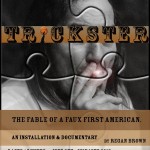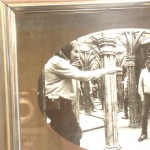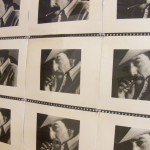The Emperor’s Contemporary Clothes: Contemporary Art as Temporary Con.
by Regan Brown
I. This Page Left Intentionally Blank.
II. To bleed or not to bleed? A Trickster’s Yip Echoes in Plato’s Cave.
“Cage described Rauschenberg’s white paintings as ‘airports for the lights, shadows, and particles…’ “.
—James Pritchett from “Writings on Cage”. [1]
“To Whom It May Concern:
The white paintings came
first; my silent piece
came later.
—J. C. ”
— John Cage from “Silence”. [2]
“…would they not assume that the shadows they saw were the real things?”
— from “The Republic by Plato” translated by Desmond Lee. [3]
The Allegory of Plato’s Cave, if you don’t already know it, runs something like this -only slightly contemporized for our purposes: we’re mostly slaves chained up and left to watch a Punch and Judy porn flick cast in shades of grey by firelight on a cave wall opposite until some mogul/ genius guy decides to helicopter out of his vaunted Madison Avenue stardom-chamber- penthouse, repel in and unbind the promising ones, leading them out into the inviolate Holiday-Sunshine Trickle-Down Tour of Fame, Freedom & The Utopian Way, whose Full HD beams might nowadays just be too unbearably bright for most of us to bump up against endlessly without some good AC, a really small Speedo/ bikini, or a surgically implanted synthetic skin. This really too white hot and globally seductive truth about the new and improved NOW is likely due to the toxic emissions that the same-said mogul/ genius guy’s profitable inventions we use keep spewing all over the atmosphere, bumping and grinding their way through irreparable holes in the ozone layer’s vaulted circumference, a manifestly materialist destiny sharply punctuated time and again by the arc of some bunker busting Icarus Drone™ rained down by Secret Agent Orange on The Anti-U.$. Bad Guy’s hole in the ground -with only minimal collateral damage done of course, and just in time for the Breaking News: This just in on Plato’s Today Show: since the birthplace of Western Civilization™ is being foreclosed on and auctioned off by its former serfs, if you hurry and call right now, you’ll be the first on your block to own your very own barely used and Pimped Up UV-Proof Titanic Trojan Horse Travelcade™ with the one and only Holographic Gladiator Amphitheater Virtual Reality Helmet™! You can stay on the run while your perfectly proportioned digital clone spends endless hours of Second Life fun redecorating the lion’s den with a lifeless supply of New Media relationship-enhancement products, hopefully helping you (or your data clone) forget that, for all intents and purposes, you’ll very soon be needing some very real superpowers in order “to be or not to be” further inland on that crowded little Hamlet at the edge of the Final Frontier, far away from the ocean’s rising red tide, most likely in a vast desert of your enemies’ own making. But wait, up there in the sky! It’s a bird, it’s the bright plane of a perfect platonic form! No, it’s the Hindenburg Advertising Satellite! Holy Hole in the Billboards Überman! The oasis was a mirage! Maybe we would’ve been better off back in the Busterless Bunker™ making Trojan horse shadow puppets from the projection booth and hoping against hope that the other jokers could’ve maybe just figured it all out on their own!?
III. From Cave to Cathedral to Cube and Back Again: The Revolution Will Be Advertised!
“The (art) work is a node in a network of forces without which it would be unrecognizable– literally invisible.”
— Martin Irvine on The Institutional Theory of Art. [4]
“Ads are the cave art of the twentieth century.”
— Marshall McLuhan [5]
“I don’t necessarily agree with everything I say.”
— Marshall McLuhan [6]
Since most spectacles nowadays are contemporaneously registered somewhere online in that Communal Subconscious Campfire Circle known as the Internet, either in the commercial laden 24-hour news cycle or on a social network/ NSA server near you, the signal to noise ratio is very high for those seeking some kind of Icons-R-Us status. To break through that and achieve some level of Fame or even Notoriety in any field, especially ArtStardom, it often takes the perpetration of a rather high-level scandal, some serious money and/ or a legitimizing platform. By legitimizing platform I generally mean an Institution of some sort (with some serious cash and some tolerance of the currency of scandal) whether it be one as well established as Russia, the MTV Video Music Awards or MOMA, right on down the food chain to smaller and smaller dictatorships, venues and portals, or even the less and less loosely-knit street art and/ or anonymous hacker movement. I mention street art to get in a word about Banksy, the Artworld’s sort of less consequential answer to Edward Snowden, and also to narrow down the daunting, raging river of Contemporary Art we’re tasked with divining here by our wonderfully intrepid editor, one that mostly riverruns under, or even sometimes overruns, the ass-fault of every Major Concrete Metropolis of our Global Vile-age, although Banksy’s work has yet to grace our particular corner of the American Gothic Gotham. Though we do have plenty of our own local Graffiti Artisans.
Banksy, loosely based it seems in Bristol and/ or LA, may just be the best known contemporaneous Trickster in ArtStardom, and once again, if you didn’t already know, his (or her? or their?) basic modus operandi is to remain cannily anonymous while creating lots of clandestine Graffiti Art and Billboard Guerilla work that is more and more often getting lifted and sold by Christie’s. He has also snuck into some major museums and practiced some “hang and run” with his own work hot-glued up on the pure white walls among some of the more famous pieces which, one has to assume, gets a wink and a nod from curators. Although Banksy’s work in and of itself is of little interest to me, being mostly adolescent one-off’s portending a sort of pseudo social self-consciousness not unlike Shepard Fairey’s illin’- formed work, the nexus of what Banksy represents, a certain mystique of illegality and play, is a relatively interesting and updated knockoff of a nearly century long “tradition” of what I think is the crux of Contemporary Art’s timeliest, and at once it’s most ancient contribution: the Anti-Art ArtisTrickster. Whether or not this contribution is consequential to the experience of being or not being we’re all subjected to daily, that place of heart and mind that Art has often staked its claim in historically, or just an empty oedipal reflex caught in a feedback loop, is an altogether trickier question.
IV. Gatekeepers, Interlopers and The Electric Synchronicity Trickster Jest.
“The prefix anti- multiplies, as if excited, around sites of contention. Before the twentieth century its main arena was theology, as in terms like “anti-Christ” and “anti-Pope.” It’s meaning is sometimes simple opposition, but sometimes a mysterious kind of interchangeability is implied; the ‘Oxford English Dictionary’ gives ‘opposite against,’ along with ‘in exchange, instead.’ “.
― Thomas McEvilley, introductory sentence to “The Triumph of Anti-Art.” [7]
“…creator and destroyer, giver and negator, he who dupes others and who is always duped himself.”
― Paul Radin, “The Trickster: A Study in American Indian Mythology.” [8]
“…there can be no signification without trickster’s duplicity, and the mind of a thief is the mind most fully able to encode and decode.”
― Lewis Hyde from “Trickster Makes This World.” [9]
‘The Bad Artists Imitate, The Great Artists Steal.”
― Picasso. Banksy. [10]
The Anti-Art Artist Ante is a long and relatively fruitful chip in the gamble of Contemporary Creativity that stretches all the way back from some flavor of the moment interloper through any multitude of experimental lineages in the relatively unwieldy and un-weeded contemporary canonical garden: the Sam Taylor Wood of “A Little Death” or “Pieta”, the Nicki S. Lee of “cultural” appropriations, Sherri Levine and her Art Appropriations, Warhol-Beuys and their sardonic-romantic Euro-American tandem, Manzoni and his cans o’ million dollar “Artist Shit”, Nam June Paik’s Video Art and yet even more interesting “accidental” pants-drop in front of President Clinton, Yves Klein and the International Klein Blue, Cage-Rauschenberg and their blanking of the slate both visually and aurally, and on and on till we hit the Glass Wall in this corner with “Da Champ”, Marcel Duchamp. In this extremely foreshortened list, what characterizes these artists in particular is a general rejection of traditionally rationalized aesthetics/ materials (that mainly paint, geometry and realism of what Duchamp might term “retinal art”) and an embrace of chance (not indeterminate) and entropic operations, industrial and promotional processes born from the harnessing of (electric) power and an abandoning of the ivory tower of monkish 2D and 3D solitude for the immediacy and sometimes bombast of the Big Top of Time-Based (4D) and New Media Art: Installation, Performance, Virtual, Internet, Sound ETC. ETC. ART. Anything BUT painting, drawing and sculpture really, though the aesthetic underpinnings of these verities, or a wholesale reaction against them, is often there. This type of work greatly “democraticized” creativity, and stormed the Bastilles of Art for those without any particularly excellent “retinal” talents, this from a generation who had moreover watched with dismay and dread as the Enlightenment Giants of Science and Reason behind much of the Vaunted Academies of Culture and Art were brought to their knees screaming in the rat infested trenches and mass graves of Two World Wars, a howl vastly punctuated with a bomb that nearly lit the atmosphere afire with a hallucinogenic mushroom cloud. This shifted much of the weight of “serious” art to the rather ironically conceptual and rather personal subconscious rather than the religio-mythical consciousness, replacing for a while at least, the methodical re-plotting of reality in illusionism for the Church or State’s sake, and removed, some would say somewhat detrimentally, much of the technical training and in many cases the class and financial obstructions that had held for centuries on a very specialized niche of trained talent in optical simulation. Add to this the increasing instantaneousness of the manipulation of photography, film, video and computer aided design, not to mention their commercial legitimization by Pop Art and, well hell, painting and company were left, to a large degree, sucking down the digital dust, nearly mocked as an almost archaically quaint “Old Europe” cave scrawl by some. “Why does art have to be on a wall or a canvas for Christ’s Sake!? Why does writing have to be on a page or film in a movie theater, or theater in a theater for that matter?” many caught in this Modern and Postmodernist “Descent into the Maelstrom” began to ask, and found, much like Poe’s character in a short story by the same name, that escape actually took some rather adroit conceptual ratiocination. You couldn’t just throw anything at the blank white walls and survive, and luckily enough security was hired to stop the Futurists from lobbing explosives at the “nostalgic” old vintage stuff.
Of course this New Media double-edged Sword of Damocles dangles over both artists and museums much in the same way digital video sort of temporarily threatened Hollywood, or Digital Downloads much more so the music industry. The computer age introduced anybody with a laptop and a camera to “filmmaking” just as Internet blogging created a new New “Journalism” that is fundamentally changing Newspapers. BUT, through all this muddling and middling, most luckily the old verity of “shit in shit out” still holds sway. I’d still generally prefer to read a well-vetted article from the New York Times online than trudge through a blogged-up rant from some dude-man like me tip-toeing through the charlatan tulips. Although in our rarified, air-conditioned and constantly re-freshened Brave New (Art) World, this shit can be shined up real good with a rub, or a twerk even, of that Good Ole Scandal-Alchemy Rag. One could even call these well worn and nearly paper thin tatters “The Emperor’s Contemporary Clothes”, especially in the ever increasingly and weirdly conflated bourgeois marketplace world of fashion, music, gallery, restaurant, natural history museum, zoo, professional sports and shopping mall. Really the locus now of all these is merchandise, consumption and someone famous to hawk it. You can’t always know how or when or even if you should pull away the invisible veil and look such a Trojan Gift Horse in the mouth, especially when you’ve got to make ends meet. It takes some real transgression.
V. The Real Fake.
“What bothered me most was their lack of style. I learned early that class is universally admired. Almost any fault, sin or crime is considered more leniently if there’s a touch of class involved.”
― Frank W. Abagnale, “Catch Me If You Can: The True Story Of A Real Fake.” [11]
“I love the way capitalism finds a place—even for its enemies.”
― Banksy, in an e-mail correspondence with “The New Yorker’s” Lauren Collins. [12]
“These threats on both sides, to the shameless person and to the world around him, are, I think, what sometimes lead people to ask if the trickster isn’t really a psychopath. Certainly there are parallels.”
― Lewis Hyde from “Trickster Makes This World.” [13]
“The last chapter in any successful genocide is the one in which the oppressor can remove their hands and say, ‘My God, what are these people doing to themselves? They’re killing each other. They’re killing themselves while we watch them die.’ This is how we came to own these United States. This is the legacy of manifest destiny.” ― Aaron Huey from a TedTalk [14]
I must say that outside being a practicing New Media maker and Pro-fessor, I have some real skin in this Trickster’s game. This is not just about a distant archetype or an artistic paradigm to me; it’s about life itself. Anyhow you might as well ask what the meaning of life is when you ask the meaning of Art.
To make a long story short, (and this is almost always how I start this story), on the 500th Anniversary of Columbus Discovering America (1992), I moved to Prague just after the Velvet Revolution and met a Native American Oglala Lakota (Sioux is kind of like the n-word to them) who went by the name of Kanawa Sa-el Shunk Manitu, which can be translated as Coyote: the First Nations’ Plains Trickster Par Excellance. I had never met a Native American before in all my life growing up in America, even though my high school was named after the Lakota. The irony of this wasn’t lost on me.
Me and Sa-el, as we all called him for short, became best of friends over the next decade I lived and traveled in Central and Western Europe. He taught me much about many things, being a well read, travelled and published person. Most of all he taught me about his People, their life on the reservation and the vicious paradox of the glamorization of the “Noble Savage” in Hollywood film, while Lakota(h) children were left struggling through life amidst extreme poverty in the middle of the richest country in the world. Infant mortality rates on the reservation are often as high as some third world countries. I learned a bit about Lakotah spirituality and its similarity to the “Don Juan” books by Carlos Castaneda. How it differed completely from Christian beliefs and how Jesuit missionaries and the European/ American conquest of the West have left the once nomadic and proud peoples of the plains penned up on reservations protecting the corrupted remnants of a nearly extinct culture, one rampant with alcoholism and the diseases born of poverty that leave little hope for the future. I knew none of this. How could I? I had never met a Native American, much less ever been to a Reservation, something Sa-el found to be just sad… and the history books I had read in school mentioned little of this. I was embarrassed to say the least.
Over time I also learned about Sa-el’s own story which, unfortunately, wasn’t an uncommon one for his People. When he was around eight years old he was taken off the reservation by the federal orphanage authorities after his grandfather was arrested for performing an illegal ceremony involving the sacrifice of the then endangered buffalo. His teacher at an orphanage in St. Louis sold him on the black adoption child market to an Italian family in Boston who had a birth certificate forged to give him a new identity. He worked “like a slave” laying floors for a few years for the family company till he could reason out, through Hollywood Film and the library, where he was from geographically, and then he ran away, setting off on an extraordinary life that encompassed most of the major events (at least for the neo-hippie kid I was) of the second half 20th century: the Freedom Buses, Haight-Ashbury, The Chicago Eight, Woodstock, The Second Wounded Knee, etc. etc. He had come to Prague for specific reasons, for a vision he had had many moons ago…(you can read the long story and see a draft of the documentary at www.tricksterdocumentary.com and see images from my recent “Trickster: The Fable of a Faux First American” Installation below).
Sa-el passed away in 2002 shortly after we had returned together to the States to make a documentary about his extraordinary life. Not long after that, three of Sa-el’s friends, two from Germany, one from Australia and I went out to the Pine Ridge Reservation in South Dakota to return some of his things, because Michigan, where he had been buried, wouldn’t allow him to be cremated as there was no “real” next of kin I knew of to sign off on such a legal document. Identifying him as Native American proved much trickier than I had imagined as well. We spent nearly two weeks on Pine Ridge checking the records of the post office, the school he claimed to have attended, names he had mentioned in the audio-biography he had written and I had helped him record. Admittedly, the records kept on the reservation aren’t the most accurate, but even the timeline of events in Sa-el’s audio-biography weren’t adding up. We were dealing with the Bureau of Indian Affairs representatives who Sa-el had told us were notoriously corrupt…but there had to be something or someone to corroborate his story. But there wasn’t…and we were beginning to feel a little foolish…and it was time to leave. I then entered a real hall of mirrors from which I still haven’t exited.
You may have seen this next part coming, but I didn’t. Yes, Sa-el had made the whole carefully crafted story up. In a time and a place like Prague pre-internet/ mobile revolution, it wasn’t all that difficult. Paradoxically enough, what finally synched this realization many years later, after setting it all again and again on the back burner, was a simple Google search of his complete name as it appeared in his passport, the name his “adopted” family had given him. This almost immediately yielded an obituary for what would turn out to be his biological father, and surviving brothers and sisters. This further led to a son and wife he had never mentioned, and on and on with further revelations, the most important, for me at least, being that these shifting shadows of persona, even of reality itself, are not the illusion we will someday be released from into a greater and brighter Truth by some Deus ex machina, but are the core, and I hesitate to call them “truths”, of this brief candle we call consciousness. Maybe this is a realization that someone creating a cave painting in the flickering firelight tens of thousands of years ago already discovered, and which it took the 20th Century’s “betrayal” of the traditional to bring us back full circle to again.
The fact that several of our Contemporary Artists, after the immense horrors and equally incredible advances of the 20th and now 21st Century, have also abandoned many of the bedrock themes and even materials of a past bolstered by clouds carved of out of marble and a “God’s in his Heaven/ All’s right with the world!” mentality should really come as no surprise. I can hardly imagine any other consciousness but one deeply imbued with the lesson’s of Trickster’s glib pliability surviving and truly confronting “reality” in the current Social Darwinism of this Global Village, and preparing the mind for the sublime onslaught of the ongoing obsolescence of our version of NOW.
- Trickster – CCAC Poster
- Trickster – An Unnatural History 1
- Trickster – An Unnatural History 2
- Trickster – Duchamp Does Dallas
- Trickster – Performance Da Joseph Boyz
- Trickster – Warhola
- Trickster – Longview
- Trickster – Remington Racism
- Trickster – IDK America
- Trickster – Goodbye Sal
Regan Brown (http://www.reganbrown.com/) has advanced degrees in both Creative Writing/ Journalism (B.A. Miami Oxford, 1991) and Fine Arts (MFA, Electronic Arts, DAAP 2009). That noticeable gap is not a typo, but represents a long stint spent living and working in Post-Soviet Central Europe as a journalist, woodwind multi-instrumentalist, professor and audio/ video producer. He currently teaches Film and Video Art at The Art Academy of Cincinnati and has several in progress projects.
Bibliography:
[1] Pritchett, James. © 1998 -2007. “Writings on Cage and Others”. Retrieved from: http://www.rosewhitemusic.com/cage/
[2] Cage, John. 1973. “Silence: Lectures and Writings”, Wesleyan University Press Paperback.
[3] Plato. “The Republic”: translated [from the Greek] with an introduction by Desmond Lee. Penguin Classics [electronic resource] – 2nd edition (revised).
[4] Irvine, Martin © 2007-2013. “The Institutional Theory of Art and the Artworld”. Retrieved from: http://www9.georgetown.edu/faculty/irvinem/visualarts/institutional-theory-artworld.html
[5] McLuhan, Marshall, quoted in Robert I. Fitzhenry, The Fitzhenry & Whiteside Book of Quotations, 1993, Canada: Fitzhenry & Whiteside Limited, p. 19.
[6] N.A. McLuhan, Marshall. Retrieved from: http://www.quotationspage.com/quote/315.html.
[7] McEvilley, Thomas. 2005. “The Triumph of Anti-Art: Conceptual and Performance Art in the Formation of Post-Modernism”. McPherson & Company, p 15.
[8] Radin, Paul. 1988. “The Trickster: A Study in American Indian Mythology”. Schocken, p. 54
[9] Hyde, Lewis. 1998. “Trickster Makes This World: Mischief Myth and Art.” North Point Press.
[10] Banksy. Retrieved from: http://www.banksy.co.uk/
[11] Abagnale, Frank W. 2003. “Catch Me If You Can: The True Story of a Real Fake”. New York City, Mainstream Publishing.
[12] Banksy, in an e-mail correspondence with “The New Yorker’s” Lauren Collins.
[13] Hyde, Lewis. 1998. “Trickster Makes This World: Mischief Myth and Art.” North Point Press, p 158.
[14] Huey, Aaron. 2010. Retrieved from: http://www.ted.com/talks/aaron_huey.html














September 27th, 2013at 4:56 pm(#)
I’ve always loved the stories of tricksters, I’ve known a few – you found a good one. Wow.